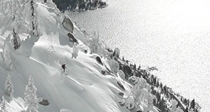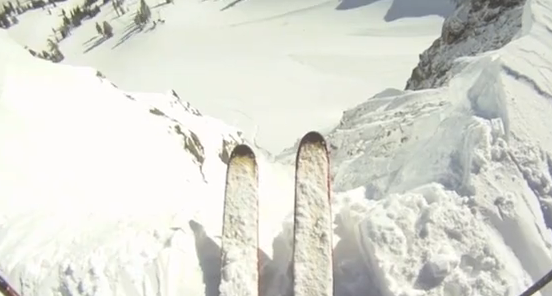by Jason Mack
I returned from Doug Stoup’s third Antarctic Ski Cruise in November. Skiing in Antarctica had been a dream for 20 years, since I saw Warren Miller footage of the remote, dramatic landscape. When I heard about Doug’s trip five years ago, I contacted him, had an intimidating interview, and was hired as one of 20 guides for the very first Antarctic Ski Cruise.
The trip of a lifetime began in November 2009, as more than 100 clients and guides made the long journey south to Ushuaia, Argentina to catch the tail end of the southern hemisphere ski season. Five years later, the same trip was every bit as magical as the first.
The 27-hour trip took us from Reno, Nevada to Ushuaia, Argentina, the southernmost city in the world. After a much needed sleep, we took a $7 taxi to the Martial Glacier for guide training and skiing. The views and expansive terrain are impressive, with steep chutes and open bowls. This and the nearby resort, Cerro Castor, make Ushuaia a bucket list destination.
After two days in Ushuaia, our crew of 118 boarded the Sea Adventurer, our floating ski condo for the next 11 days. We began steaming south down the Beagle Channel at 10 knots. Four hours later, we exited the channel and entered the Drake Passage.
November 6: We’re in the 500-mile-wide Drake Passage, the shortest crossing from Antarctica to another continent. From Cape Horn to the South Shetland Islands, the Drake connects the Pacific to the west and the South Atlantic to the East. Moderate swell ranging from 3-5 meters is hitting us abeam to starboard. The sea birds are following the ship as we suck in the cold air and stare at the blank horizon to stave off sea-sickness. There is a sense of calm being surrounded by only water and wind. We get a presentation on marine birds from the ships ornithologist, David, and a slideshow by Andrew McLean. In between delicious meals and bird watching, we nap the day away. Before bed, we watch Valhalla, by Sweetgrass Productions. It’s a great ski movie and not just for the naked ski segment.
Nov. 7: Last night between 2am and 5am, as we crossed the Antarctic Convergence, we experienced large swell up to 7 meters. The shape and design of the Sea Adventurer make it cut through the swell and minimize the pitch and roll. The sound of unsecured objects crashing in near by cabins reminds us that we’re in the Drake. Toward the end of the day, we neared the South Shetland Islands and completed our Drake crossing. We spotted Cape James as we passed by Smith Island around 2pm. As we entered the Bransfield Strait, we encountered quite a bit of brash ice (broken sea ice), enough to make us turn 180 degrees and go north until we could get around it. We were the first ship of the summer season to enter these waters and there wasn’t any good data on ice movement. Tonight, we’ll head for the Gerlache Strait and a Bay on Brabant Island. 5:30 am guide meeting tomorrow.
Nov. 8: We awoke to the ship still heading south in the Gerlache Strait. Off our starboard side, we had a stellar view of Brabant Island as we approached Chiringuano Bay. Mt. Victoria, and a vast slope at the edge of the Solvay mountains that we call The Farm, are our objectives for the day. The snow conditions look glazed and shiny. After launching several zodiacs to scout possible landings and check snow, our hunch is confirmed. Brash ice had blown into the bay and blocked any low-angle approach to the slopes. The call was made to move across the Gerlache to Ronge’ Island. Once the boat was anchored, we loaded zodiacs and I took my group to an alternate landing on Cuverville Island. As we beached the zodiac, we were greeted by a parade of hundreds of Gentoo penguins coming ashore to enter their rookery for the breeding season. We waited at the water’s edge for a break in the parade to approach the slope. Cuverville Island offers a west-facing 1000′ run with a pitch of 25-45 degrees. We made two roped ascents and both runs were good skiing in soft corn with a bit of refreeze. On our way back to the ship, we spotted Arctic Terns.
Nov. 9: We moved through the night from Ronge’ southward toward the Lemaire Channel. This is a move we have attempted every year only to be turned back by ice. The Lemaire is a spectacular fjord style channel with giant walls of granite rising strait out of the sea. We once again were confronted by ice and turned back north. Just after breakfast, we entered Paradise Harbor and approached Gonzales Vadia Station, a base operated by the Chileans. The base has a large Gentoo rookery and a nice ski slope behind it. Also known as Water Boat Point, this would be our first steps and turns on mainland Antarctica. Once ashore, we made a couple runs and then spent a little time with the penguins. I stressed to my group that it’s easy to lose site of the obvious on this trip. You can ski tour and make turns anywhere there is snow, but you can’t experience Antarctica until you slow down and let the gravity of the place hit you.
Nov. 10: I awoke feeling terrible with a painful cough, burning throat, fever and headache. My first thought is, “I could take the whole ship down with this if I’m not careful about containing my illness”. My second thought is, “You’ve got to be kidding me.” After toughing out the guide meeting and being too embarrassed to admit being sick, I tracked down the ship’s doctor and displayed my symptoms. She gave me antibiotics, and some DM cough syrup that is probably illegal in the U.S. I decided to suck it up and pretend I wasn’t sick. The weather today was absolutely gorgeous. The plan was ski in Charlotte Bay near Mt. Zeppelin. After a scouting mission proved that brash ice was blocking all the landing zones, we pulled anchor and turned north. Plan B was becoming the standard. As we moved north we had a clear view of Nansen Island, which had an incredibly vast snowfield and a protected landing site between itself and Independence Island. This enormous slope offered a 1600 ft. climb and a long cruiser decent in many directions. Feeling as sick as I did, it was a bad idea to leave the ship. I didn’t want to let my group down by handing them off, so I put my head down and went on with the day. My group and I are bonding well and our dynamic is melding into a nice groove. We toured around Nansen Island for half the day, making three long gentle runs that seemed to go forever. As the afternoon went on, I started to feel worse and worse. Being satisfied with the outing and concerned for my well-being, my group insisted that I retreat for the ship. Once off the mountain we climbed aboard a zodiac and toured a small harbor on Independence Island for an hour. We saw Crabeater seals, Weddell seals, and an old whaling ship that had caught fire and run aground to save the crew.
Back on the ship, the crew decided to do the polar plunge and stern deck BBQ. Doug Stoup and a few others went for a short stand-up paddle on the glassy arctic waters. I went strait to bed and slept through the festivities and forever sunset, waking up 14 hours later.
Nov. 11: After the long sleep and 24 hours of antibiotics, I was feeling better, but not well enough to fake it again. Word was out that I was ill and Kim Havell took my group so I could rest and recuperate. The groups went ashore in a low, cloudy haze to hit the objective we started yesterday. We were in Charlotte Bay again near Mt. Zeppelin and we looking for a giant, floored crevasse that you could walk through, dubbed the Blue Room. Today’s weather was not as stellar as yesterday, but the skiing was good and group loved the rare opportunity to walk through a hallway of ten 10,000-year-old ice. After returning for lunch, the ship moved a short distanced to Buff Island where groups went back out for another ski session. Buff Island has a long approach but offers a few steep skiing options. I spent the day in bed. Fortunately, I was the only one out of 120 passengers who was ill.
Nov. 12: Yesterday’s rest and the antibiotics have me back on my feet. Through the night we returned north across the Bransfield Strait to the South Shetland Islands toward Livingston Island in the McFarlane Strait, dividing Greenwich Island and Livingston. As we arrived in the strait at 5 am, the winds were gusting to 50 mph and the clouds hung low on the peaks that I so wanted to see. Livingston Island has been my favorite place to ski on the previous trips. The terrain is varied, visually spectacular and there is less glaciation to avoid. The ship moved around until we found shelter behind Half Moon Island. This allowed the groups to split up where some would ski in the low visibility and the others would head for Half Moon to spend time with the Chinstrap penguins. Those who hedged on the morning penguin excursion were hoping for clearing skies in the afternoon. Unfortunately that didn’t happen but, after lunch, we set out in the zodiacs across rough water to ski on Livingston nonetheless. The wind in the strait was blowing hard and the zodiac ride was a wet one. We were taking full waves over the boat against our backs as we went towards the landing. By the time we hit shore, my pants wet soaked through to my skin. We quickly roped up and toured off into the milky white before the cold set in. The visibility on glaciated terrain in a low hanging cloud can cause vertigo, so we skinned up toward the only rock buttress we could see. We skied back down the same way we came up. Although it was hard to see, the snow was good and we made a quick second lap before heading back, through the chop, to the ship for dinner. The meals aboard the Sea Adventurer are fantastic! Breakfast, lunch, and dinner are different every day and the menu and service are top-notch. The waitstaff is comprised of a great group from all around the world, who goes out of their way to provide amazing service. By the end of the week you develop a rapport with them and you wish they lived in your hometown.
Nov. 13: The ship sat tight for most of the night. We pulled anchor around 4 am and moved east to King George Island (KGI). We entered Admiralty Bay with the intent to go deep into the bay and turn west into a channel that held good ski descents. This was our last day before the ship would turn north and once again enter the Drake Passage. A low-pressure system was moving in and the same winds we were plagued with yesterday were in full force again. It was too windy and visibility too poor for the ship to go where we intended. Yet again Plan B would be the call. The ships expedition leader, Alex, had called the near by Arctowski Polish base and asked if we may come ashore for a visit. They obliged and it was explained to the groups that the wind and weather would only increase and skiing would not be an option for the last day. We will for sure return to this area on future trips, as there are many great skiing options within site of the base. This would be a great opportunity to visit a base where scientists and researchers lived year round. They had not had visitors since last summer so they were welcoming and showed us around. Unfortunately, they were running low on their lab-distilled vodka so we didn’t imbibe. While ashore, we happened to be watching a pair of Adelie penguins go from shore to a near by iceberg when suddenly one of them was attacked by a Leopard seal. The seal violently thrashed the penguin around in its mouth until its turned inside out, presumably so the seal wouldn’t have to eat the feathers. This was a classic National Geographic moment. After milling around the base and beach, looking at the many enormous whale bones, we noted that the weather was picking up again and we returned to the ship. As we pulled anchor and began our voyage home, a few of us stayed up top to bid our farewell to Antarctica the Shetlands.
Nov. 14-15: Crossing the Drake Passage, with a Beaufort wind scale 6 to 9, there was lots of relaxing, reflecting and sleeping. This was my third trip to the Antarctic Peninsula, and instead of it becoming old hat or mundane, I am just as blown away by the place as I was the first time. It reminds me of my early years pioneering the helicopter skiing terrain around Cordova, Alaska. At first we just skied all of the obvious lines, but as time went on, we discovered some of the best runs were between the lines, so to speak. I look forward to discovering the runs between the lines in Antarctica in the near future.
Nov. 16: We are back in Ushuaia by early dawn for goodbyes and exchanges of emails and addresses. We disembarked and make our way to a hostel for the night to get some rest before the long flight home.
If this trip sounds like something you’ve always wanted to do, feel free to contact me with questions you may have about next year’s cruise. Ice Axe Expeditions has secured the Sea Adventurer for another trip in Nov. 5-17, 2014. Get more information or book your spot before it sells out. Please tell them J. Mack sent you!










Recent Comments